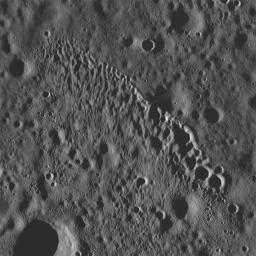
|
Stream of Secondary Craters
- Click the image above for a larger view
- Full-Res JPEG (1000 x 1000) (181.3 kB)
- Full-Res TIFF (1000 x 1000) (1.0 MB)
Caption:
LROC NAC frame showing a string of secondary craters from an impact crater to the north, probably Giordano Bruno. Image width is 4.5 km.
A northwest-trending string of fresh secondary craters formed by debris thrown out of a larger impact, most likely Giordano Bruno (525 km to the north). The chain is about 4.5 km long and the largest crater at the southeast end is about 340 m in diameter. The morphology of the impact suggests that the debris impacted the surface at a low angle, heading to the south. Smaller pieces at the northwest end churned and scoured the surface while the larger pieces at the southeast end formed round craters. Secondary craters are common on the lunar surface and occur both in chains and as isolated small craters. It is easy to identify secondary craters when they form in chains, but it is much more difficult to distinguish individual secondary craters.
Background Info:
NASA's Goddard Space Flight Center built and manages the mission for the Exploration Systems Mission Directorate at NASA Headquarters in Washington. The Lunar Reconnaissance Orbiter Camera was designed to acquire data for landing site certification and to conduct polar illumination studies and global mapping. Operated by Arizona State University, the LROC facility is part of the School of Earth and Space Exploration (SESE). LROC consists of a pair of narrow-angle cameras (NAC) and a single wide-angle camera (WAC). The mission is expected to return over 70 terabytes of image data.
Cataloging Keywords:
| Name | Value | Additional Values |
|---|---|---|
| Target | Moon | |
| System | Earth | |
| Target Type | Satellite | |
| Mission | Lunar Reconnaissance Orbiter (LRO) | |
| Instrument Host | Lunar Reconnaissance Orbiter | |
| Host Type | Orbiter | |
| Instrument | Lunar Reconnaissance Orbiter Camera (NAC) | |
| Detector | Narrow Angle Camera (NAC), Wide Angle Camera (WAC) | |
| Extra Keywords | Crater, Grayscale, Impact | |
| Acquisition Date | ||
| Release Date | 2009-08-05 | |
| Date in Caption | ||
| Image Credit | NASA/GSFC/Arizona State University | |
| Source | photojournal.jpl.nasa.gov/catalog/PIA12895 | |
| Identifier | PIA12895 | |
